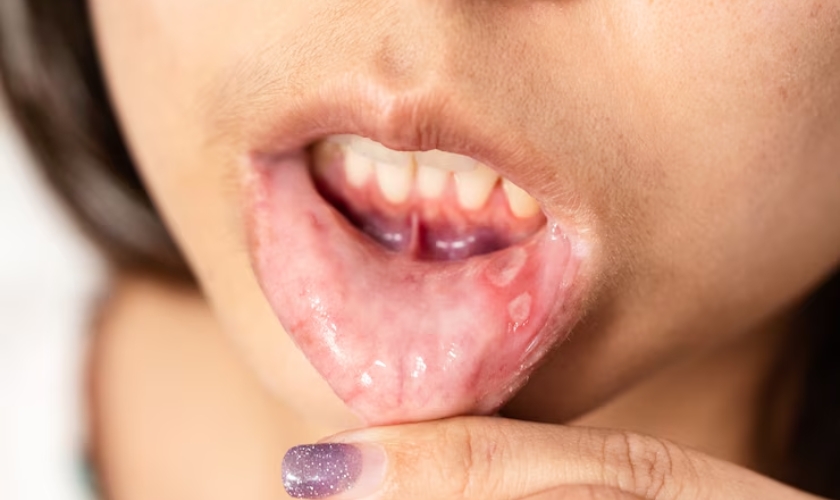704-844-2943
AVAILABLE FOR EMERGENCIESUnderstanding Oral Cancer: Causes, Symptoms, Risk Factors, and Treatments

Oral cancer also referred to as mouth cancer, is the most prevalent type of head and neck cancer, primarily affecting individuals aged 60 and older. It can affect various areas within the mouth, including the lips, tongue, roof, and floor of the mouth, as well as the oropharynx, which includes the base of the tongue, soft palate, tonsils, and the walls of the throat. In this blog, we will delve into the causes, symptoms, risk factors, and treatments associated with oral cancer. Understanding these aspects will empower you to take proactive measures to safeguard your oral health.
What is Oral Cancer?
Oral cancer refers to cancer that occurs within the mouth. It may manifest as white patches or sores on the lips or in the mouth that bleed and do not heal. If untreated, oral cancer can spread to other parts of the mouth, throat, head, and neck. Approximately 63% of people diagnosed with oral cavity cancer survive for at least five years after diagnosis.
Who is Affected by Oral Cancer?
About 11 out of every 100,000 people will develop oral cancer in their lifetime, with men being more susceptible than women. Additionally, white individuals are more likely to develop oral cancer compared to Black individuals.
How Does Oral Cancer Affect the Body?
Oral cancer can impact both the mouth and the oropharynx. The oropharynx includes parts of the tongue, the roof of the mouth, and the middle part of the throat visible when the mouth is open. Cancer in the oropharynx is known as oropharyngeal cancer. This article focuses on oral cancer in the mouth or oral cavity.
Parts of the Oral Cavity
- Lips
- Gums
- Lining inside the cheeks
- First two-thirds of the tongue
- Floor of the mouth (under the tongue)
- The first part of the roof of the mouth
- The area behind the wisdom teeth
Symptoms and Causes
What Causes Oral Cancer?
Oral cancer begins in the squamous cells of the oral cavity. These flat cells, resembling fish scales under a microscope, become cancerous when their DNA changes, and they start to grow uncontrollably. Over time, these cancerous cells can spread to other parts of the mouth, head, neck, and body.
Risk Factors for Developing Oral Cancer
About 75% of oral cancer cases are linked to the following habits:
- Smoking cigarettes, cigars, or pipes
- Using smokeless tobacco products (chewing tobacco, dip, snuff, water pipes)
- Excessive alcohol consumption
- Prolonged sun exposure without lip protection
- Human papillomavirus (HPV) infection
- Family history of oral cancer
Notably, 25% of oral cancer cases occur in individuals without any of these risk factors.
Symptoms of Oral Cancer
Oral cancer symptoms can mimic common oral issues but persist longer and do not heal. Key signs include:
- Non-healing sores on the lips or inside the mouth
- Rough spots or crusty areas on the lips, gums, or inside the mouth
- Unexplained bleeding in the mouth
- Numbness, pain, or tenderness in the face, neck, or mouth
- Difficulty chewing, swallowing, speaking, or moving the jaw or tongue
- Unintentional weight loss
- Earache
- Chronic bad breath
Diagnosis and Tests
How is Oral Cancer Diagnosed?
Dentists may identify potential oral cancer during regular checkups and recommend further tests or refer to specialists. Diagnostic methods include:
- Physical Examination: Inspection and palpation of the mouth, head, face, and neck.
- Brush Biopsy: Scraping the area to collect cells for examination.
- Incisional Biopsy: Removing tissue samples for analysis.
- Laryngoscopy and Pharyngoscopy: Using mirrors or endoscopes to examine the throat and mouth.
Stages of Oral Cancer
Cancer staging helps determine the cancer’s location and spread. The TNM system is used, where T describes the tumor size and location, N indicates lymph node involvement, and M denotes metastasis.
- TI: The tumor in your mouth measures 2 centimeters or less.
- T2: The tumor is 2 centimeters or smaller but isn’t larger than 4 centimeters.
- T3: The tumor is larger than 4 centimeters.
Options for Oral Cancer Treatments
Treatment typically involves surgery, radiation therapy, and chemotherapy. Factors influencing treatment choice include the type of oral cancer, its spread, the patient’s health, and age.
Surgical Oral Cancer Treatments
- Primary Tumor Surgery: Removing tumors via the mouth or neck incision.
- Glossectomy: Partial or total removal of the tongue.
- Mandibulectomy: Surgery for cancer in the jawbone.
- Maxillectomy: Removing part or all of the hard palate.
- Sentinel Lymph Node Biopsy: Checking if cancer has spread.
- Neck Dissection: Removing lymph nodes from the neck.
- Reconstruction: Reconstructive surgery following extensive tissue removal.
Other Oral Cancer Treatments
- Radiation Therapy: Using energy beams to kill or inhibit cancer cells.
- Targeted Therapy: Drugs that specifically target cancer cells.
- Chemotherapy: Anti-cancer drugs that kill cancer cells.
- Immunotherapy: Engaging the immune system to fight cancer.
Prevention
Tips to Prevent Oral Cancer:
- Quit or reduce smoking and tobacco use.
- Limit alcohol consumption.
- Use UV-blocking lip balm.
- Get vaccinated against HPV.
- Maintain a balanced diet.
- Regular dental check-ups and oral cancer screenings are performed every three years for those aged 20-40 and annually after 40.
Self-Examination for Oral Cancer:
- Feel your lips, gums, and the roof of your mouth.
- Check your neck and jaw for lumps.
- Use a mirror to inspect your mouth.
- Tilt your head back to examine the roof of your mouth.
- Pull out your cheeks to view inside.
- Pull out your tongue and check its top, bottom, and sides.
Early identification is vital for the effective treatment of oral cancer. During routine oral cancer screenings, your dentist will thoroughly examine your mouth for any signs of the disease. They may recommend additional tests such as an oral brush biopsy or imaging scans if needed. Early detection allows for less invasive treatment options and significantly improves the chances of a successful recovery.
Oral cancer is a serious but manageable condition. By understanding the risk factors, symptoms, and the importance of regular oral cancer screenings, you can take proactive steps to manage your oral health and potentially avoid a life-threatening situation. Schedule an appointment with your trusted Matthews dentist today for a comprehensive oral cancer screening in Matthews, NC. Together, we can ensure a healthy smile for many years to come.
